Etude

En Bref
- Traditional financial planning and budgeting processes revere the annual calendar, leaving companies unable to respond quickly to sudden market changes.
- The volatility of both supply and demand in recent years has raised the value of dynamic financial planning.
- Beyond Budgeting, a framework developed two decades ago, helps companies cultivate dynamic financial planning.
- Our survey of CFOs found that leaders in financial planning emphasize Beyond Budgeting principles, such as setting targets based on external benchmarks, organizing around accountable teams, and connecting plans to customer priorities.
Many companies in recent years have stumbled in their financial planning. As just one example, consider how Peloton, the exercise equipment and training company, made highly optimistic consumer demand forecasts, assuming that the surge of demand during the Covid-19 pandemic would last. The problem was compounded by a gummed-up supply chain that deterred potential new customers. Peloton’s planning wasn’t flexible enough to adjust quickly to changes in demand and supply. The result: a large new factory it will never use and has to sell, and a drop in market capitalization from nearly $50 billion in January 2021 to $3.3 billion in June 2022.
With the risk of a recession rising, companies in most industries will have their financial planning processes severely tested in the coming year. Take US retail. Walmart, Amazon, and Target missed quarterly investor earnings expectations as inflation hit 40-year highs, and both Covid and Russia’s war in Ukraine caused cascading supply chain disruptions. After the companies announced earnings, Walmart’s stock price had its worst day since October 1987, Target had its worst day in 35 years, and Amazon fell to a two-year low.
The need for more dynamic financial planning—which replaces a fixed annual exercise with a flexible approach that responds to changing conditions—is nothing new. Many business leaders and chief financial officers (CFOs) have struggled to change rigid, time-consuming, and unresponsive financial planning processes. Traditional planning methods led firms to be caught flat-footed by external shocks, unable to quickly adapt or reallocate money and other resources.

Strategy-Making in Turbulent Times
Writing for the Harvard Business Review, Bain partners Michael Mankins and Mark Gottfredson describe what it takes to produce great results in uncertain times and propose a practical model for strategy development.
This predicament has grown more acute with the volatility of recent years, and brittle planning methods are creating headaches for financial leaders. In a new Bain survey of 240 CFOs in the US and Europe, they overwhelmingly cite financial planning and analysis (FP&A) as their top priority (see Figure 1).
CFOs say financial planning and analysis is their top functional priority

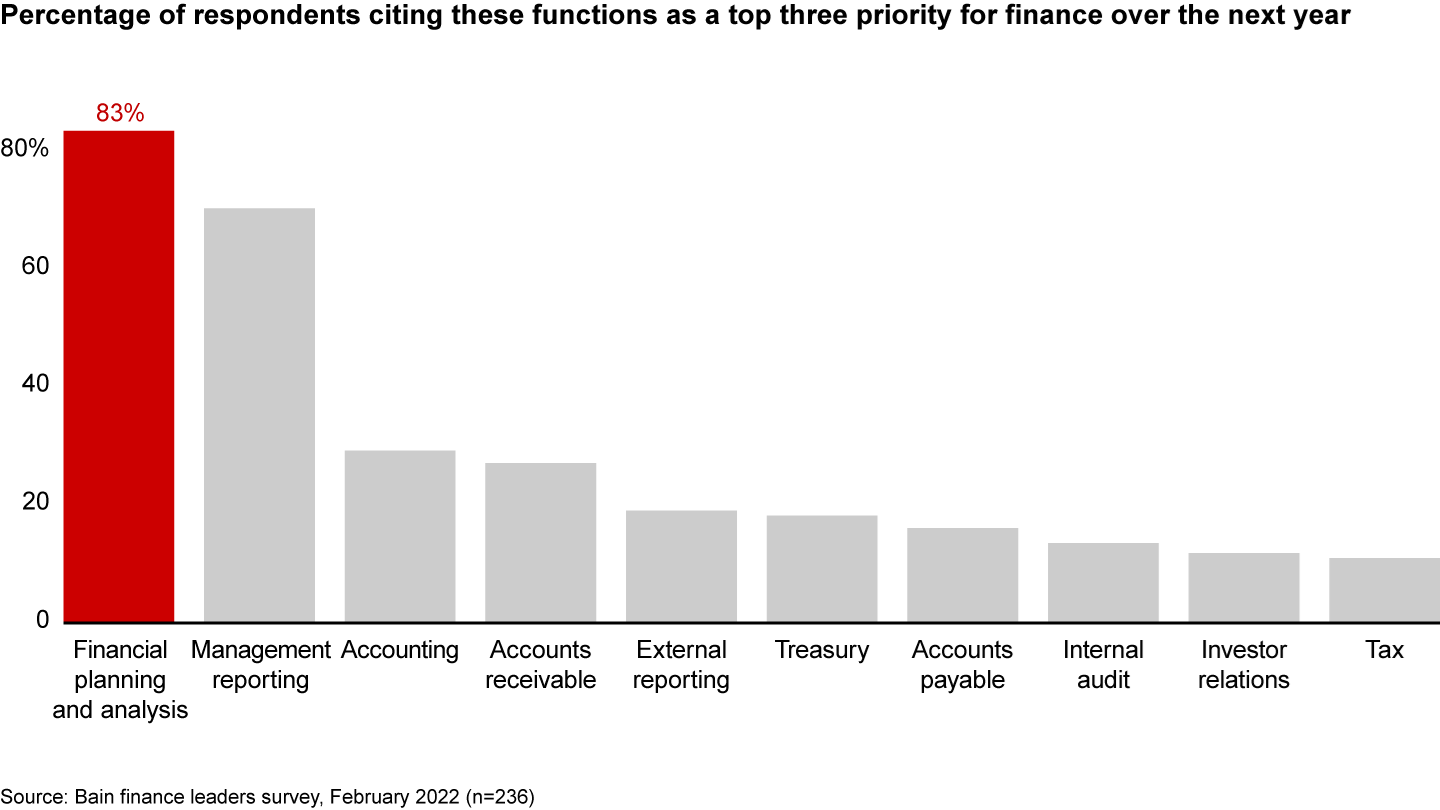
So why do many business and finance leaders still make do with traditional planning processes? One reason is that a long stretch of strong economic growth plus low inflation allowed companies to ignore a lot of dysfunction.
But that situation has ended. Markets and business risks are more uncertain and volatile, as illustrated by the gyrations in commodities such as oil, steel, and wheat, as well as intermediate goods such as semiconductor chips. Most businesses have grown more complex, with new customers, geographies, business models, and channels to contend with. Many companies are adopting new ways of working, including remote work, cross-functional teaming, and Agile methods. Yet financial planning processes haven’t kept pace to address these more fluid business conditions.
What financial planning leaders do differently
Most CFOs and finance departments aspire to be trusted partners of their business units. A good FP&A team understands where money is made or lost across the business and helps senior leaders see around corners while illuminating the risks and opportunities within the organization and externally. FP&A finds the “story” hidden in the financial data and provides meaningful insights to help a business make better decisions and execute the strategy.
To do that, a company needs financial planning that excels in five outcomes: accuracy, timeliness, flexibility, innovation, and value. Consistently achieving high levels of these outcomes is hard, with only 13% of the CFOs in our survey saying they do.
Beyond Budgeting, a framework developed as an alternative to traditional annual budgeting, helps companies cultivate dynamic financial planning. Beyond Budgeting originated in Europe in 1998 and has been embraced in whole or in part by a broad range of global companies, including Toyota, Danone, Maersk, and Handelsbanken. Beyond Budgeting consists of 12 principles—6 leadership principles and 6 management processes (see Figure 2).
The Beyond Budgeting framework works through two sets of principles

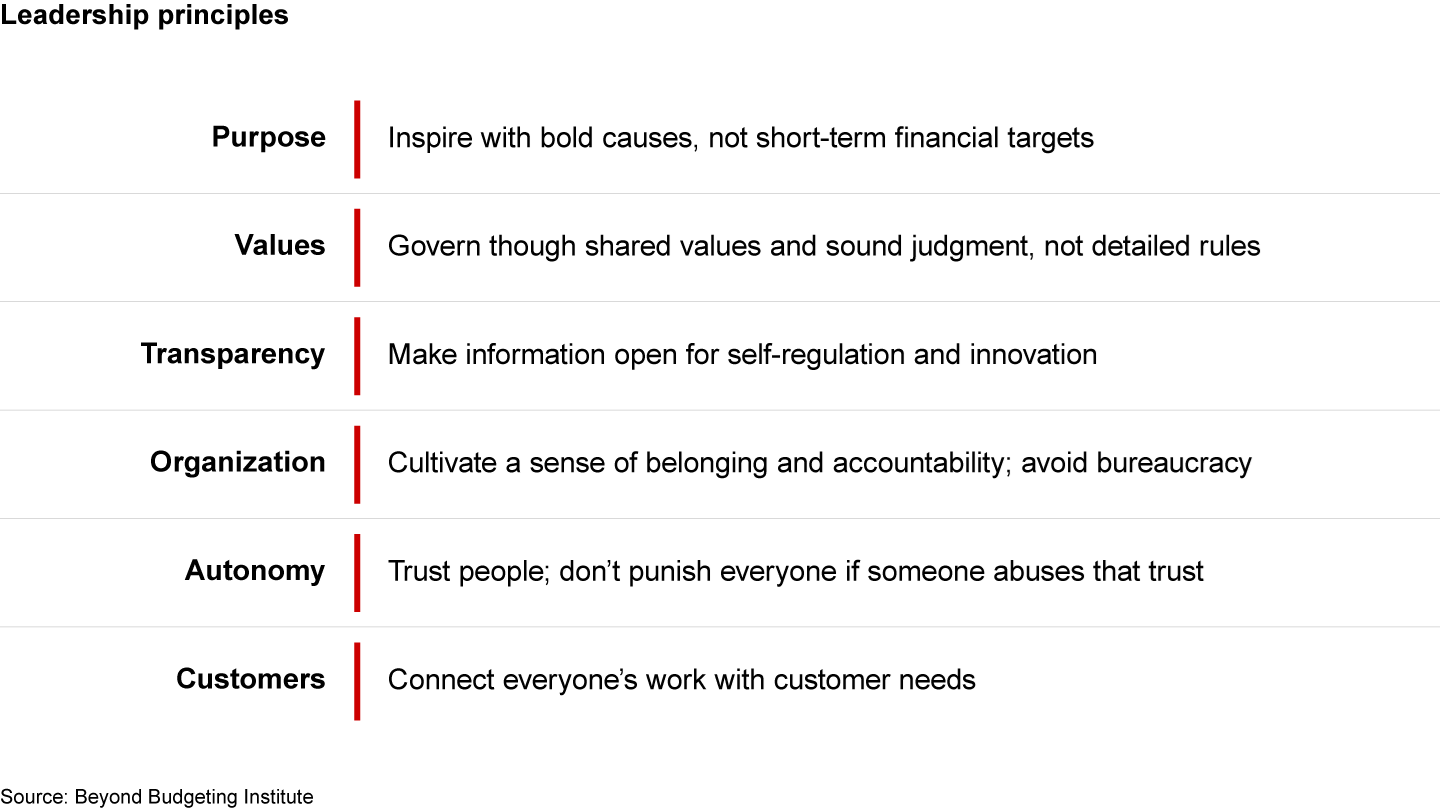
The Beyond Budgeting framework works through two sets of principles

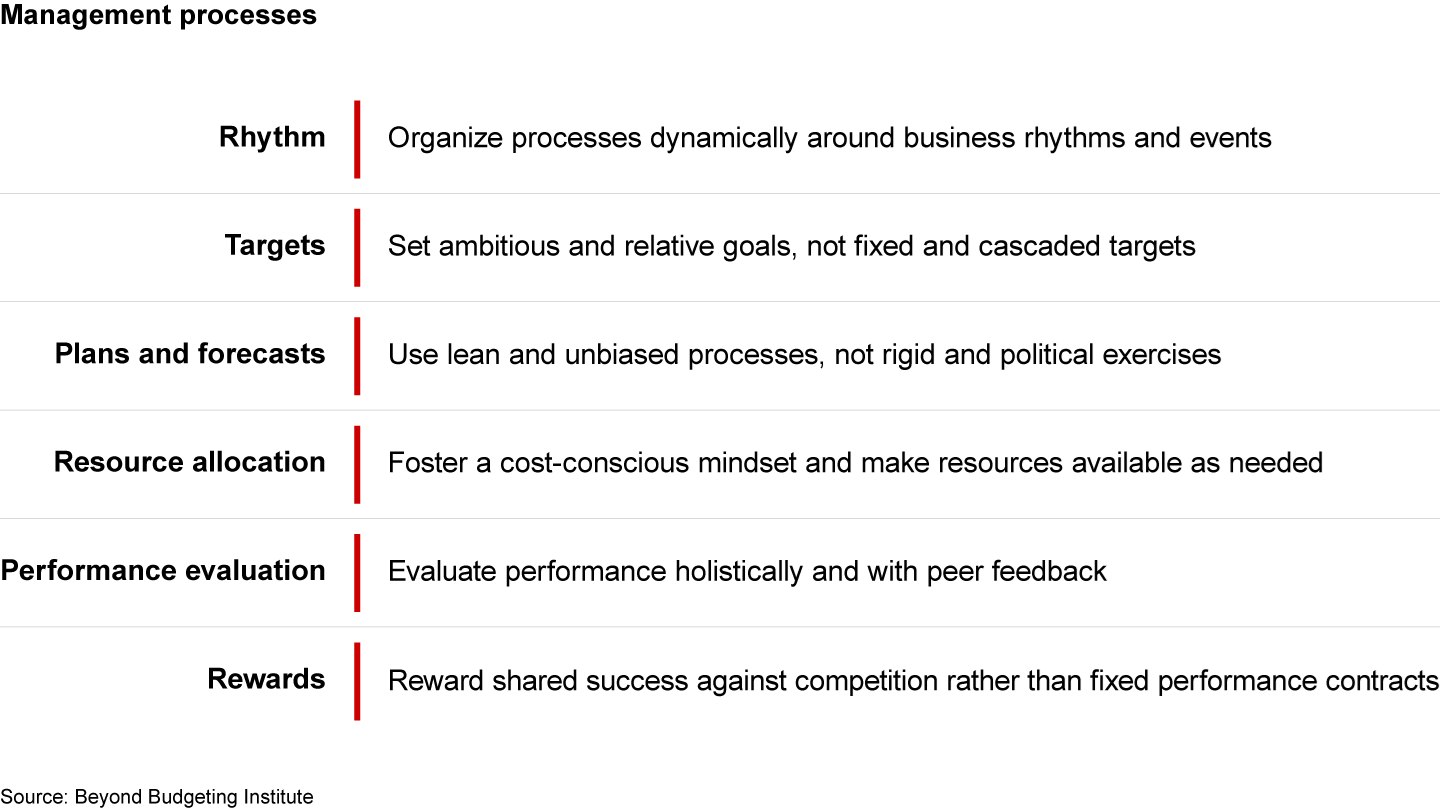
In our survey, the 13% of companies that lead in the key financial planning outcomes are twice as likely as other firms to adopt many of the principles and management processes of Beyond Budgeting (see Figure 3).
The gap between leaders and others is particularly large on five principles. The first two involve an intense focus on customers and on organization, to minimize hierarchical control and bureaucracy. Too many companies embed a lot of detail in the process of allocating resources, sometimes down to the department or manager level for operating expenses, or down to the individual project for capital planning. While minute detail creates accountability and visibility, it can hinder the business if market and business conditions change during the year and a company cannot adjust plans quickly.
Leading firms in financial planning are twice as likely as others to adopt many Beyond Budgeting principles

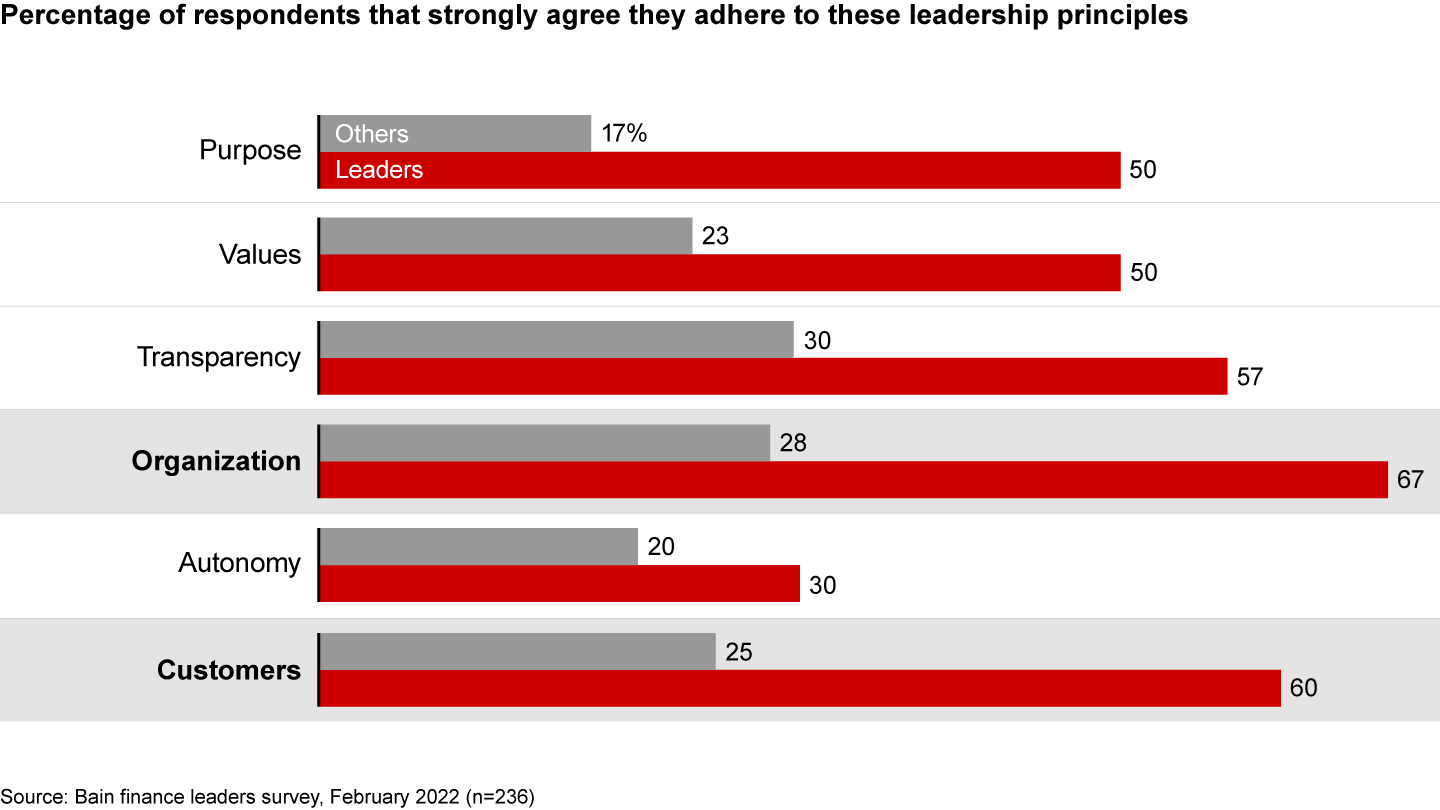
Leading firms in financial planning are twice as likely as others to adopt many Beyond Budgeting principles

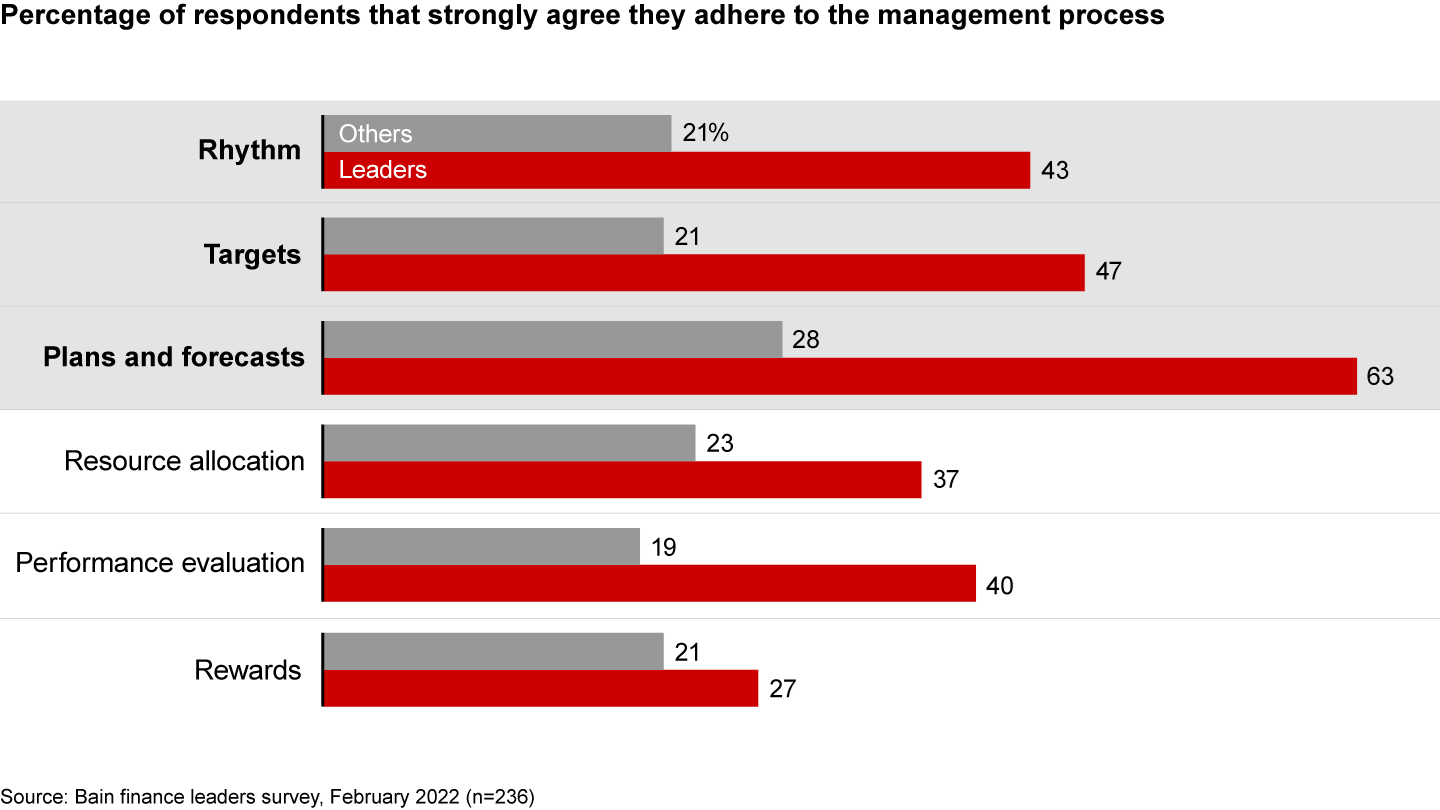
The leaders, by contrast, streamline the level of detail in planning. For example, a fast-growing software company simplified its annual planning from 160 different organizations to five organizations with 35 operational areas. It then allocated resources for each operational area.
Turning to management processes, planning leaders spike in the rhythm principle—organizing processes around business conditions and events rather than the calendar year. Given the pace at which markets are changing, businesses need a good deal of flexibility, so the leaders create formal mechanisms and processes for reallocating resources and capital within the year. Some companies open access to funding outside of the annual plan, in order to fund innovation or “change the business” initiatives. The previously mentioned software company created three formal reviews every year with the opportunity for business heads to recommend reallocating resources among the areas they manage.
Planning leaders also excel in their target setting. Many companies take the seemingly easy route of basing the next year’s target as a percentage over the current year. Plans and forecasts flow accordingly. However, internally negotiated, fixed targets don’t work in dynamic situations. Instead, leaders set targets based on benchmarks linked to the business strategy, and they often separate target setting from planning and forecasting. This keeps them focused more on winning in the market than on hitting internal targets, and provides a realistic view of actual business performance.

Accelerated Performance Transformation
Break through to a new level of performance
The leaders in our survey use externally oriented planning and forecasting practices. Most annual plans derive from internal bargaining, not from objective, data-driven processes for resource allocation. Some finance departments try to compensate by implementing a rolling forecast, with a shorter interval for volatile and uncertain markets. A few companies have even eliminated the annual plan entirely in favor of a rolling forecast. A rolling forecast, however, does not in itself achieve dynamic planning. If the forecasting process is highly complex and manual, finance can fall into the trap of rebudgeting or reforecasting with the same level of effort as traditional budgeting.
Our survey revealed that leaders in financial planning don’t use a rolling forecast much more than other firms. But they do use certain techniques significantly more often than others. In particular, the leaders more often use scenario planning, driver-based planning, external benchmarking to set targets, more dynamic forms of forecasting than a traditional rolling forecast, and predictive analytics including artificial intelligence (AI) (see Figure 4).
Firms that lead in financial planning are likelier to adopt more dynamic and externally facing practices

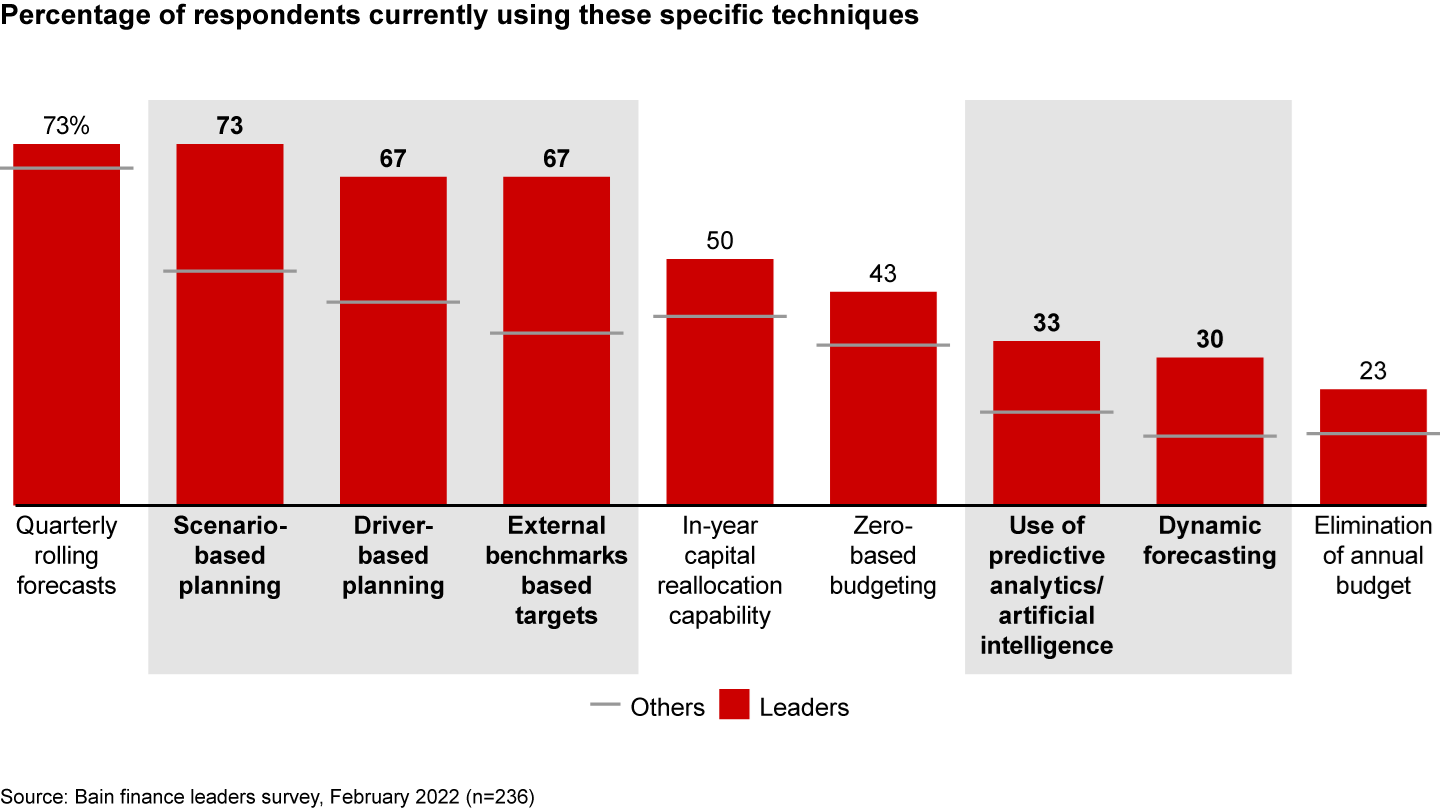
Three paths to more dynamic planning
There are three paths that companies can take to make their financial planning more dynamic: streamline the current planning process, augment it with new techniques, or reinvent the process. The first two can be effective in the short term, but for lasting benefits, companies should consider ultimately taking the third path.
Streamlining the current planning process. Some companies can take six months or longer to prepare an annual budget, or three weeks to prepare a forecast. Their annual budgets may contain hundreds of line items, and require multiple cycles to prepare, reconcile, consolidate, and approve. Streamlining would reduce planning time to 30 days, trim the level of detail and number of budget cycles, more effectively sequence work to ensure it’s being done in the right order in the right way, and use technology to automate as much work as possible.
One large mining company simplified its cumbersome, 32-week budget process, which had consisted of endless reports, meetings, reconciliations, consolidations, and debates. The company standardized and resequenced the process, clarified roles, and focused on fewer metrics. These moves allowed the firm to cut the budget cycle in half, while shining a spotlight on the metrics and performance drivers that mattered most to the business.
Augment the current planning process with new techniques. A step beyond streamlining involves augmenting the current process with new, often innovative, techniques. Firms can add a rolling forecast, or go further by adopting scenario planning.
One emerging technique applies AI, specifically machine learning, to forecasting. AI can not only improve forecasting accuracy, it also significantly speeds up the process, freeing up the finance team time to extract better business insights.
A global consumer products company had to deal with a tangled, sprawling approach to revenue forecasting models, with business units taking different approaches involving hundreds of people for half a month. By applying AI, the company reduced the time needed to forecast revenues from two weeks to two hours, while accuracy reached 97% or more.
Reinvent the planning process. No amount of streamlining or augmenting with new techniques can address the fundamental flaws of annual budgeting. Some companies thus are choosing to go a step further and pursue entirely new ways of planning.
Amazon has reinvented the budget process by putting customer priorities at the center. It allocates funding to activities, not business units, with each activity evaluated on how it affects customers. For each new activity, the owner creates a six-page planning document that contains a future press release describing the benefits to customers. Unlike traditional management reviews that focus on financial metrics, Amazon’s reviews focus on real-time customer metrics.
Some companies adopt the Beyond Budgeting framework in whole or in part. Beyond Budgeting seeks to accomplish more than just eliminating the annual budget. It decentralizes accountability to frontline teams so the business can quickly respond to market opportunities or shocks.
Hilti, a Swiss manufacturer of building products for the construction industry, began shifting away from traditional budgets more than 15 years ago. Hilti first made many of its targets relative rather than absolute, and linked its bonus system to progress toward these targets. It replaced annual budgeting with three rolling forecasts per year, each with only 100 line items. Performance management focused on comparing actual financial performance with a previous period’s performance and against established targets, rather than comparing the budget to actual performance. From 2011 to 2021, Hilti was able to adapt its financial planning amid disruption in the power tools industry, a global pandemic, and supply chain shocks, as revenue grew 1.5 times and net income by 7 times over the period.
New skills wanted
Finance as a trusted partner, a source of competitive advantage—it all comes back to the FP&A organization. FP&A should understand the business strategy, how the company makes money, and how it will evolve in the future. FP&A will also need to align with internal and external stakeholders on the key drivers of business performance and total shareholder value.
To improve planning, FP&A will need to add people from backgrounds other than accounting and standard MBA programs, such as data analytics and data science. That type of talent can help extract the key business insights from data, rather than spending time manipulating spreadsheets.
Blending the right processes with the right talent and technology, to create truly dynamic financial planning, allows a company to adjust quickly and confidently to the shocks coming its way.